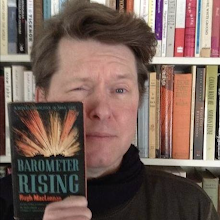
We first encounter Barbara as a nymph-like, sylph-like orphan, newly arrived in pre-Revolutionary Connecticut from Maryland. Carefree and careless, self-absorbed and intolerant, Barbara is "one of those who colour the moods of others by their own, and are therefore apt to be at fault in their interpretation of another's motives."
Like that other orphan Anne Shirley, whose story would appear in bookstores six years after Barbara Ladd, she's an unusual, unconventional girl. How unusual? How unconventional? Sir Charles treats the reader to a description of her sexually charged "mad negro" dance:
She danced with arms and hands and head and feet, and every slender curve of her young body. She moved like flames. Her eyes and lips and teeth were a radiance through the live, streaming darkness of her hair. Light, swift, unerring, ecstatic, it was like the most impassioned of bird-songs translated into terms of pure motion.
The novel has few characters. There's Barbara's Aunt Mehitable, who as a stern, joyless figure won over by her lively charge, bares a resemblance to Marilla Cuthbert. Young, talkative Richard Gault provides interaction with someone Barbara's own age. Finally, there are the doctors Jim and John, two bachelor brothers who together serve as the moral compass of the community. The two siblings spend much of the novel vying for the love of Mehitable; as in this exchange, which begins with Doctor John getting down on one knee before her "black-satin-shod small feet":
"Nothing more utilitarian than silk stockings, most dear and unexpected frivolous lady," he vowed, "shall be my tributes of devotion to you henceforth!"
"And mine shall be garters, fickle Mehitable!" cried Doctor Jim, dropping on his knee beside Doctor John, and swearing with like solemnity. "Silk garters, – and such buckles for silk garters!"
"And little silk shoes, and such big buckles for little silk shoes!" said Doctor John.
"And silk petticoats!" went on Doctor Jim, antiphonally. "Brocaded silk, flowered silk, watered silk, painted silk, corded silk, tabby silk, paduasoy silk, alamode silk, taffety silk, charrydarry –" till Mistress Mehitable put her hand over his mouth and stopped the stream of eruditions.
"And silk – and silk –" broke in Doctor John, once more, but stammeringly, because his knowledge of the feminine wardrobe was failing him.
Yes, Doctor John, best stick with shoes – buckled shoes – your brother is the petticoat expert.

Fun and fetishes are, sadly, set aside with the advent of the American Revolution. As the mood shifts, Richard declares his love for Barbara, but is rejected because he is not a Patriot. When he leaves to fight on the side of the Loyalists, she writes him off... but Roberts never writes him out. We know that it is only a matter of time before headstrong Barbara will accept Richard's love. Will it be when he's injured fighting a duel in defence of her honour? No, the moment comes only when he's lying near death in her arms... and even then, Richard feels obliged to give up his fight for George III.
For some, loyalty will always take second place to the love of a beautiful woman... no matter how headstrong she might be.
Trivia: Roberts' working title, the oddly appropriate Mistress Barbara, was changed after the 1901 publication of a Halliwell Sutcliffe novel by the same title.
Object: Voyeurs will be disappointed to learn that Carré designed the cover, but not the interior. The colour illustrations above, by Frank VerBeck, come from two of the four plates found in the first edition.
Access: For a novel that sold over 80,000 copies in the United States alone, Barbara Ladd isn't nearly as common as one might expect. A decent copy of the first edition will likely set you back C$50. As usual, library users will find universities to be the best bet. Here's to the public libraries of Toronto and Vancouver for keeping it on their shelves.

















